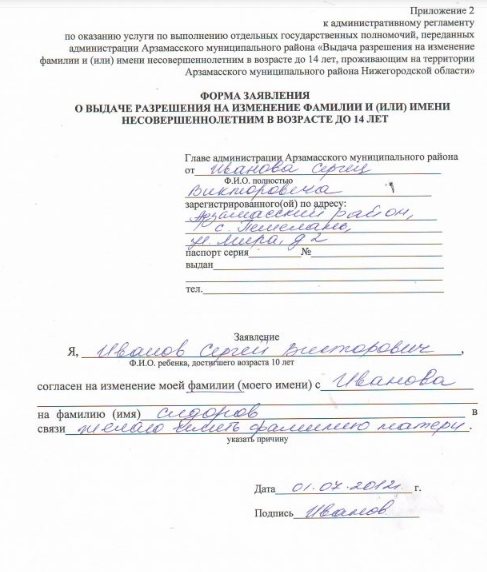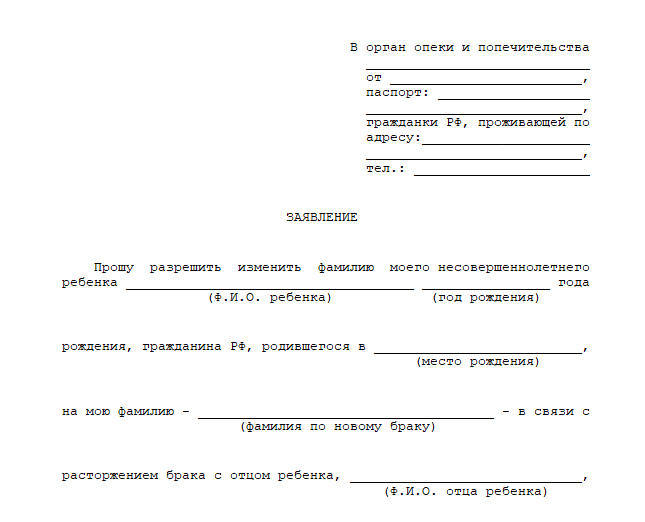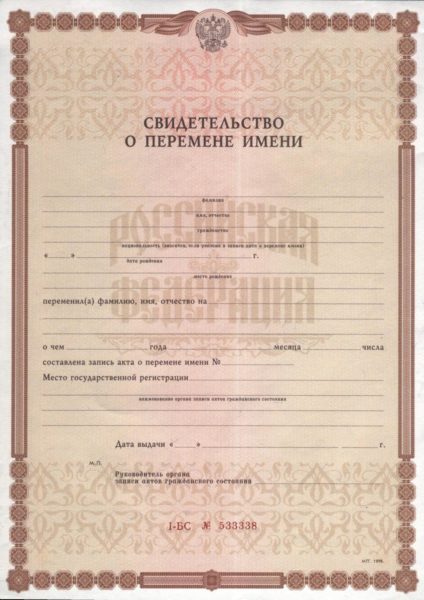Reasons for changing your surname at age 14
Situations due to which parents may need to change the surname of a minor child can be very different. But speaking in general terms, most often the need for this procedure arises for the following reasons:
- Divorce between spouses. The parent who keeps the child may want to change his last name. For example, a mother may decide to give her daughter her maiden name.
- Deprivation of one of the spouses of parental rights. In such cases, the child often wants to change his last name on his own initiative.
- The death of the father or his recognition as missing.
- Detention of one of the parents.
- Among the most common reasons is the situation when a woman whose child bears her last name (for example, if paternity has not been established) gets married. If the new spouse decides to adopt a child, then the woman accordingly has the need to change the surname of her daughter/son to the surname of her husband.
How to change a child's surname at 14 years old
There can be several ways to change the surname of a minor: before receiving a passport or after the document has been issued; Sometimes it is necessary to change the name of a child under 14 years of age. Each option should be considered separately.
Changing your last name when receiving a passport
At the age of 14, the little citizen receives his first passport.
If a child wants to receive a passport with a new surname, then you must first carry out the procedure of changing the surname (as well as the first name, if required), obtain a birth certificate with updated data, and then receive a passport for the new name.
Otherwise, you will first have to issue a passport in your old name, and then change it to a document with a changed name. In this case, you will need to pay a state fee to replace your existing ID card.
Since we are still talking about a minor, in order to change the name when receiving a passport, the consent of both parents will be required. If there are no grounds for disregarding the disagreement of the father or mother, the matter will have to be resolved in court.
Changing the surname of a child under 14 years of age
In order to change the surname of a child under the age of 14, either the consent of both parents is required, or compelling reasons are limited to the will of only one of them. Thus, changing the surname of a child under 14 years of age without the consent of the father will be possible, for example, if the child has been deprived of parental rights.
Moreover, in the case of children over the age of 10 years, the consent of the child himself will also be required, which will need to be formalized in writing by the guardianship and trusteeship authority.
Changing your last name after issuing an identity card
Many citizens are interested in whether a child can change his last name at the age of 14 after receiving a passport. For example, if the child himself wanted to change his name. We answer - yes, such a possibility is permitted by law. The essence of the procedure is similar - obtain written permission from the parents or take evidence confirming that the permission of one of them is not necessary. You will also need to write an application on behalf of the person on whose initiative the procedure is being carried out and provide other necessary papers.
In cases where not the entire package of documents has been collected or when there are some aspects that impede the name change, the applicant may be denied this legal procedure. Please note that such a decision must be accompanied by official explanations from the person in charge. All transferred documents must then be returned to the owners.
Is it possible to change a child's last name without adoption?
The right to change the personal data of a minor is vested in:
- blood parent, with the consent of the guardianship department, - in relation to a child under 10 years ;
- blood parent, with the consent of the guardianship department and the minor - in relation to a son/daughter aged 10 to 14 years ;
- a minor, with the consent of a guardian or blood parent, between the ages of 14 and 18 years .
Important! Changing the surname of a ward aged 14 to 18 years with the data of the trustee is not a reason for the emergence of a family relationship between the minor and the legal representative.
The law prohibits a guardian from changing the personal data of a ward. Identification of the fact of everyday changes in data can be interpreted as a violation of children's rights. The exception is when the guardian plans to adopt the child in the future.
Example . Tatyana was the guardian of the minor Polina. The girl was in care from infancy. The woman knew that if adopted, she would lose the right to guardianship benefits. Therefore, I decided to postpone the registration until the girl needs to go to 1st grade. However, at home the ward was called Caroline and her birthday was celebrated on a different date. During the trial, the court granted the request to change personal data. However, the date of birth was retained.
Procedure for changing your last name
Since it is impossible to provide an exhaustive list of documents, do not forget to first clarify how to change a child’s last name in your particular case, what documents will need to be collected for this. For this purpose, you can sign up for a consultation with a lawyer or contact the guardianship authority or the registry office with the relevant question. Otherwise, your request will simply be denied.
Next, all papers, along with an application for a name change, must be submitted to the guardianship authority corresponding to the child’s place of residence. This can be done either in person, by mail, or through your legal representative. In the latter case, you will first have to issue a notarized power of attorney for the person who will act on your behalf in this matter.
After the documents have been reviewed, the specialist from the guardianship authority will issue his opinion. This will be either a refusal with recommendations for further action, or permission allowing you to proceed to another stage of the procedure.
Contacting the registry office
If the guardianship authority has approved your application, the next organization you will need to contact is the registry office corresponding to the child’s place of residence, or the registry office that issued him a birth certificate. In addition to the documents, the application will need to be accompanied by a receipt for payment of the state fee.
At this stage, you will again have to be patient, since this government agency will also check the possibility of changing your last name in your situation.
Submitting an application to change your surname

In the application to change your last name, you will need to not only inform about your request, but also tell about the reason for this procedure: why exactly you made such a decision. For greater persuasiveness, it would not hurt to refer to the relevant articles and paragraphs of legislation. And, of course, you will need to indicate which last name you would like to see on the child’s birth certificate and/or passport.
What documents are needed
Required documents include:
- Parents' passports.
- Child's passport (if available).
- Child's birth certificate.
- Application for name change.
- A certificate from housing authorities about the minor’s place of residence.
In addition, depending on the circumstances of a particular case, you may need:
- Marriage/divorce certificate.
- Certificate of establishment of paternity/deprivation of parental rights.
- A document confirming the fact of the parent's incapacity.
- A document confirming that one of the parents is listed as missing.
- Death certificate of mother/father.
- A certificate from the bailiff service stating that the parent is a debtor to pay child support.
As for the registry office, less paperwork may be required here, since the bulk of the work will be done by the guardianship and trusteeship authority. The standard list looks like this:
- Passports of parents and child (if he has one).
- Statement.
- Permission from the guardianship authority.
- Birth certificate.
- Receipt for payment of state duty.
But in some cases, you may again be required to provide some additional documents.

Change of surname at the initiative of one parent
Let's consider the possible options:
- Non-payment of maintenance funds. The most compelling argument for changing a child’s surname without the father’s consent is the latter’s failure to pay money for the child, for example, alimony. To exercise this right, the mother must document that the father does not actually transfer money to his child.
- Absence of father at place of registration. The child's father decides to leave his family, and sometimes this is accompanied by leaving the place of registration. In such a situation, the mother has the right to change the surname of her child, even without obtaining consent from the other parent. But if his relatives live at the address where the child’s father is registered, it is their responsibility to notify the father about the actions performed by the mother of his child.
- Official recognition as incompetent. If the baby's father suffered a serious illness that negatively affected his physical or mental state, he may be declared incompetent. If there is a court decision, the child’s mother has the right to change his surname to her own. To change personal data, the mother must provide to the registry office, along with the main documents, a conclusion from a medical institution confirming the diagnosis.
- Making a court decision on deprivation of parental rights. To change a child's surname due to deprivation of his father's parental rights, an appropriate court decision will be required.
- Self-removal from raising a child. This circumstance can be confirmed by obtaining testimony from witnesses - those close to the family. This can be not only relatives and friends, but also educators, teachers, and clinic staff. The guardianship authorities evaluate how reliable all the testimony presented is.
- Refusal to participate in the child's life. In practice, it turns out that proving the fact of a father’s non-participation in the life of his young child is quite problematic. To do this, the mother will have to find witnesses who can confirm that the father really does not care for the baby in any way, and all care of the minor is entrusted to his mother. A kindergarten teacher, an educational institution teacher, and neighbors can be brought in as witnesses.
- The birth of a child outside of marriage. If the fact of paternity in relation to the child has not been officially established, and the relationship between his parents has not been formalized, the mother has the right to give him her last name. By law, she is the only parent of such a baby, and, therefore, has the right to expect that he will grow up with his last name. If the father has been officially identified, it is possible to have him declared invalid.
Read also: Payments at the birth of a child in 2021
Is it possible to change the middle name?
According to the law, changing a child’s patronymic name is allowed at any time after adoption. As a rule, this situation arises after the mother enters into a new marriage, when the baby is given not only the surname of the new father, but also his patronymic.
Among other situations when a change of patronymic is allowed, we can highlight:
- There is no information about the father.
- The certificate was filled out from the words of the mother.
- The father has no parental rights.
- The child turned fourteen years old.
Receiving a passport with new data
To receive a passport with new data, you need to contact the Migration Department of the Ministry of Internal Affairs of the Russian Federation at the child’s place of residence with an application drawn up according to a standard form. It must be accompanied by the parents’ passports, the child’s old passport and a birth certificate issued by the registry office with a new surname. You will also need a receipt for payment of the state duty. The standard time frame for obtaining a new identity card is 10-14 days. But if the application is submitted to a place other than the child’s place of residence, then you need to be prepared to wait much longer. Up to 2 months.
Changing your last name through the MFC
Another way to simplify your task is to visit the nearest multifunctional center that provides state and municipal services to the population. Through it you can complete documents faster.
On the main website of the MFC of the Russian Federation you can find a list of departments throughout the country. It also contains the addresses of the websites of regional MFCs, where you will find contact information or even a form for making an online appointment with a specialist.
The procedure for changing a name through the MFC is extremely simple:
- Collect a package of papers (identical to the one we have already described).
- To write an application.
- Submit papers to the MFC.
- Wait for the documents to be verified and the final decision on your issue.
- As a result, you will receive either a certificate of name change or a refusal.
Procedure for changing personal data
Let's take a closer look.
Instructions
The personal data of a minor cannot be changed without obtaining written consent from his legal representatives.
All documents are transferred to the registry office, where the employee enters the data into the journal, after which he reports to other state and municipal institutions about the need to make changes to the databases. The period within which the employee must consider the received application is 30 days, after which the applicant must be issued a certificate with new data or a reasoned refusal to make changes to the child’s personal data.
Documentation
To change a child’s last name, a parent will need to take care of collecting documents:
- A statement indicating the reason for the changes.
- A copy of the certificate confirming the registration of marriage or divorce.
- Certificate for the child.
- Consent of the other parent.
- A copy of the housing account.
- Consent from the child, if at the time of application he is already 10 years old.

Sample consent from a child
Sometimes the registry office requires an additional certificate from the educational institution where the child is studying.
Drawing up an application
Changing the child’s data is carried out by the registry office employee after receiving an application from his parents. This document must indicate the reason why the legal representative made such a decision.
Without obtaining consent from the child's father
Changing a child's surname without obtaining consent from his natural father is possible only in a few exceptional cases. In other situations, consent from the second parent is a mandatory requirement, otherwise the mother will be refused to change her child’s data.

Sample application to change a child's surname
After the divorce is finalized
After a divorce is filed between the parents, the child almost always remains to live with the mother, who in turn wants to change her surname to her maiden name. A child’s full name can be changed only if a positive response is received from both of his parents.
If the child is already ten years old, his consent will be required to change his data.
Read also: How to pay for kindergarten with maternity capital?
Changing a surname before and after a child turns 14 years old
The age of the child may entail some peculiarities when changing his surname:
- While the child is not yet ten years old, obtaining his consent to change personal data is not required, since he is considered too young to make such a decision independently.
- Upon reaching the age of ten, in order to change the surname, the child’s consent will be required.
- After a child turns fourteen years old, he already has the right to independently decide on which surname to go with.
Mother's entry into a new marriage
A change of a child’s surname can also occur after the mother’s remarriage. The baby, like his mother, receives the surname of his new family after registering a new marriage. To change her full name, the mother must attach a certificate of registration of a new marriage to the list of basic documents.
Documents receiving
To obtain a new certificate, the applicant must contact the registry office with an application and accompanying documents confirming the validity of the request.
The period for consideration of the received application is stipulated in the legislation, and is currently 30 days. After this time, the applicant is issued a certificate with new data on the child or a reasoned refusal that it is impossible to carry out such a procedure.

Form of certificate of change of surname
Changing your last name after adopting a child
If a change in the child’s surname occurs as a result of the completion of measures for his adoption, then a corresponding court decision must be submitted to the government agency as a supporting document.
Is it allowed to change a surname without parental consent?
The answer to the question whether it is possible to change a surname at the age of 14 without the consent of the father and mother at the same time will be ambiguous. On the one hand, if both or at least one parent/guardian have retained their parental rights, are alive and capable, and participate in the upbringing and maintenance of the child, then he will not be able to change his name without their permission. If there are grounds to assert that the mother and father do not have any rights to the child, then it will still be possible to realize this desire, but only through the court.
Find out more about how to change a child’s surname without the father’s consent.








